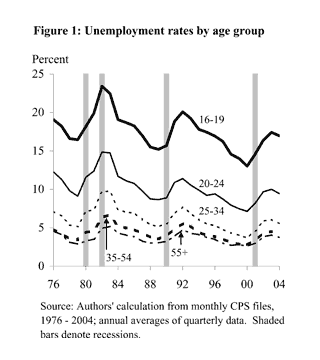Previously, Political Calculations(TM) looked at the Federal Reserve Bank of San Francisco's research into the correlation between an individual's level of education and the likelihood of their being unemployed. That same research also found a strong correlation between age and the likelihood of their unemployment, revealing that the young are far more likely to be jobless than older members of the workforce.
The following chart from the San Francisco Fed's research illustrates the level of unemployment by age group from 1976 through 2004:

Clearly, the young jobseeker is at a disadvantage, having a significantly higher rate of unemployment, through both boom times and busts, than older groups. The authors note that (emphasis added):
... the difference is most striking for teenagers (age 16-19), whose unemployment rate typically is about three or more times that of people aged 35 and over. Informal observation and systematic analysis both point to high rates of job turnover among young workers as an explanation for higher equilibrium unemployment rates among these groups.
The high rate of job turnover for those aged 16-19 would be expected since this age range corresponds with the later years of high school and the beginning years of college in the United States, which would impact the ability of members of this age group to be consistently employed on a full time basis.
In addition, this age group would also be the most unskilled of the workforce (as measured by experience or by education), further limiting their employment opportunities.
The Fed's researchers also mapped the percentages of the labor force by age over the period from 1976 to 2004:

This chart allows us to see the effect of the aging of the workforce as the disproportionately large baby boom generation shifts the levels of employment for each age group.
Overall, the aging of the workforce provides a partial explanation of why the level of unemployment for all age groups has tended to decline over the period from 1976 to 2004. The Fed's researchers conclude that combined with education, the aging of the workforce only explains "about one-half or less of the decline in the unemployment rate over the past few decades."
The other half or more of the explanation will likely keep the Fed's researchers well employed....
Welcome to the blogosphere's toolchest! Here, unlike other blogs dedicated to analyzing current events, we create easy-to-use, simple tools to do the math related to them so you can get in on the action too! If you would like to learn more about these tools, or if you would like to contribute ideas to develop for this blog, please e-mail us at:
ironman at politicalcalculations
Thanks in advance!
Closing values for previous trading day.
This site is primarily powered by:
CSS Validation
RSS Site Feed
JavaScript
The tools on this site are built using JavaScript. If you would like to learn more, one of the best free resources on the web is available at W3Schools.com.